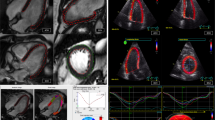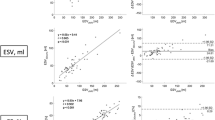Abstract
Computed tomography (CT)-derived three-dimensional maximum principal strain (MP-strain) can provide incremental value to coronary CT angiography for cardiac dysfunction assessment with high diagnostic performance in patients with myocardial infarction. Global longitudinal strain (GLS) measured using two-dimensional speckle tracking echocardiography (2D-STE) is more sensitive than left ventricular ejection fraction (LVEF) for detecting early myocardial dysfunction. We aimed to compare CT-derived MP-strain with each of 2D-STE-derived strains (i.e., longitudinal, circumferential, and radial strains), and identify the major determinants of CT-derived MP-strain among 2D-STE-derived strains. We studied 51 patients who underwent cardiac CT and echocardiography. CT images were reconstructed at every 5% (0–95%) of the RR interval. A dedicated workstation was used to analyze CT-derived MP-strain on the 16-segment model. We calculated CT-derived global MP-strain with all the 16 segments on a per patient basis. Pearson’s test was used to assess correlations between CT-derived MP-strain and STE-strain at global and segmental levels. The intra-class correlation coefficient for interobserver agreement for CT-derived global MP-strain was 0.98 (95% confidence interval 0.96–0.99). The low-CT-derived global MP-strain group (≤ 0.43) had more patients with LV dysfunction than the high-CT-derived global MP-strain group (> 0.43). CT-derived global MP-strain was associated with STE-GLS (r = 0.738, P < 0.001), global circumferential strain (r = 0.646, P < 0.001), and global radial strain (r = 0.432, P = 0.001). In multivariate analysis, STE-GLS had the strongest association to CT-derived global MP-strain among three directional STE-strains and LVEF by echocardiography (standardized coefficient = − 0.527, P < 0.001). STE-GLS is a major determinant of CT-derived global MP-strain. CT-derived MP-strain may enhance the value of coronary CT angiography by adding functional information to CT-derived LVEF.




Similar content being viewed by others
References
Ponikowski P, Voors AA, Anker SD, Bueno H, Cleland JGF, Coats AJS, Falk V, González-Juanatey JR, Harjola VP, Jankowska EA, Jessup M, Linde C, Nihoyannopoulos P, Parissis JT, Pieske B, Riley JP, Rosano GMC, Ruilope LM, Ruschitzka F, Rutten FH, van der Meer P, ESC Scientific Document Group (2016) 2016 ESC guidelines for the diagnosis and treatment of acute and chronic heart failure: the task force for the diagnosis and treatment of acute and chronic heart failure of the European society of cardiology ESC developed with the special contribution of the Heart Failure Association (HFA) of the ESC. Eur Heart J 37:2129–2200
Yancy CW, Jessup M, Bozkurt B, Butler J, Casey DE Jr, Drazner MH, Fonarow GC, Geraci SA, Horwich T, Januzzi JL, Johnson MR, Kasper EK, Levy WC, Masoudi FA, McBride PE, McMurray JJ, Mitchell JE, Peterson PN, Riegel B, Sam F, Stevenson LW, Tang WH, Tsai EJ, Wilkoff BL (2013) 2013 ACCF/AHA guideline for the management of heart failure a report of the American College of Cardiology Foundation/American Heart Association Task Force on Practice Guidelines. J Am Coll Cardiol 62:e147–e239
Lang RM, Badano LP, Mor-Avi V, Afilalo J, Armstrong A, Ernande L, Flachskampf FA, Foster E, Goldstein SA, Kuznetsova T, Lancellotti P, Muraru D, Picard MH, Rietzschel ER, Rudski L, Spencer KT, Tsang W, Voigt JU (2015) Recommendations for cardiac chamber quantification by echocardiography in adults: an update from the American Society of Echocardiography and the European Association of Cardiovascular Imaging. Eur Heart J Cardiovasc Imaging 16:233–270
Smiseth OA, Torp H, Opdahl A, Haugaa KH, Urheim S (2016) Myocardial strain imaging: how useful is it in clinical decision making? Eur Heart J 37:1196–1207
Amzulescu MS, De Craene M, Langet H, Pasquet A, Vancraeynest D, Pouleur AC, Vanoverschelde JL, Gerber BL (2019) Myocardial strain imaging: review of general principles, validation, and sources of discrepancies. Eur Heart J Cardiovasc Imaging 20:605–619
Motoki H, Borowski AG, Shrestha K, Troughton RW, Tang WH, Thomas JD, Klein AL (2012) Incremental prognostic value of assessing left ventricular myocardial mechanics in patients with chronic systolic heart failure. J Am Coll Cardiol 60:2074–2081
Vach M, Vogelhuber J, Weber M, Sprinkart AM, Pieper CC, Block W, Kuetting D, Attenberger UI, Luetkens JA (2021) Feasibility of CT-derived myocardial strain measurement in patients with advanced cardiac valve disease. Sci Rep 11:8793
Tavakoli V, Sahba N (2014) Cardiac motion and strain detection using 4D CT images: comparison with tagged MRI, and echocardiography. Int J Cardiovasc Imaging 30:175–184
Pilla JJ, Koomalsingh KJ, McGarvey JR, Witschey WRT, Dougherty L, Gorman JH, Gorman RC (2015) Regional myocardial three-dimensional principal strains during postinfarction remodeling. Ann Thorac Surg 99:770–778
Tanabe Y, Kido T, Kurata A, Sawada S, Suekuni H, Kido T, Yokoi T, Uetani T, Inoue K, Miyagawa M, Mochizuki T (2017) Three-dimensional maximum principal strain using cardiac computed tomography for identification of myocardial infarction. Eur Radiol 27:1667–1675
Kawaguchi N, Kurata A, Kido T, Nishiyama Y, Kido T, Miyagawa M, Ogimoto A, Mochizuki T (2014) Optimization of coronary attenuation in coronary computed tomography angiography using diluted contrast material. Circ J 78:662–670
Shrimpton PC, Hillier MC, Lewis MA, Dunn M (2006) National survey of doses from CT in the UK: 2003. Br J Radiol 79:968–980
Yoshida K, Tanabe Y, Kido T, Kurata A, Uraoka D, Kinoshita M, Uetani T, Nishimura K, Inoue K, Ikeda S, Yamaguchi O, Mochizuki T (2020) Characteristics of the left ventricular three-dimensional maximum principal strain using cardiac computed tomography: reference values from subjects with normal cardiac function. Eur Radiol 30:6109–6117
Cerqueira MD, Weissman NJ, Dilsizian V, Jacobs AK, Kaul S, Laskey WK, Pennell DJ, Rumberger JA, Ryan T, Verani MS (2002) American heart association writing group on myocardial segmentation and registration for cardiac imaging. standardized myocardial segmentation and nomenclature for tomographic imaging of the heart. a statement for healthcare professionals from the cardiac imaging committee of the council on clinical cardiology of the American heart association. Circulation 105:539–542
Lang RM, Badano LP, Mor-Avi V, Afilalo J, Armstrong A, Ernande L, Flachskampf FA, Foster E, Goldstein SA, Kuznetsova T, Lancellotti P, Muraru D, Picard MH, Rietzschel ER, Rudski L, Spencer KT, Tsang W, Voigt JU (2015) Recommendations for cardiac chamber quantification by echocardiography in adults: an update from the American society of echocardiography and the European association of cardiovascular imaging. J Am Soc Echocardiogr 28:1–39
Voigt JU, Pedrizzetti G, Lysyansky P, Marwick TH, Houle H, Baumann R, Pedri S, Ito Y, Abe Y, Metz S, Song JH, Hamilton J, Sengupta PP, Kolias TJ, d’Hooge J, Aurigemma GP, Thomas JD, Badano LP (2015) Definitions for a common standard for 2D speckle tracking echocardiography: consensus document of the EACVI/ASE/Industry Task Force to standardize deformation imaging. J Am Soc Echocardiogr 28:183–193
Kanda Y (2013) Investigation of the freely available easy-to-use software “EZR” for medical statistics. Bone Marrow Transplant 48:452–458
Tsuji K, Sakata Y, Nochioka K, Miura M, Yamauchi T, Onose T, Abe R, Oikawa T, Kasahara S, Sato M, Shiroto T, Takahashi J, Miyata S, Shimokawa H (2017) Characterization of heart failure patients with mid-range left ventricular ejection fraction—A report from the CHART-2 Study. Eur J Heart Fail 19:1258–1269
Meta-analysis Global Group in Chronic Heart Failure (MAGGIC) (2012) The survival of patients with heart failure with preserved or reduced left ventricular ejection fraction: an individual patient data meta-analysis. Eur Heart J 33:1750–1757
Kovács A, Oláh A, Lux Á, Mátyás C, Németh BT, Kellermayer D, Ruppert M, Török M, Szabó L, Meltzer A, Assabiny A, Birtalan E, Merkely B, Radovits T (2015) Strain and strain rate by speckle tracking echocardiography correlate with pressure-volume loop-derived contractility indices in a rat model of athlete’s heart. Am J Physiol Heart Circ Physiol 308:H743-748
de Lucia C, Wallner M, Eaton DM, Zhao H, Houser SR, Koch WJ (2019) Echocardiographic strain analysis for the early detection of left ventricular systolic/diastolic dysfunction and dyssynchrony in a mouse model of physiological aging. J Gerontol A Biol Sci Med Sci 74:455–461
Stokke TM, Hasselberg NE, Smedsrud MK, Sarvari SI, Haugaa KH, Smiseth OA, Edvardsen T, Remme EW (2017) Geometry as a confounder when assessing ventricular systolic function: comparison between ejection fraction and strain. J Am Coll Cardiol 70:942–954
Park JJ, Park JB, Park JH, Cho GY (2018) Global longitudinal strain to predict mortality in patients with acute heart failure. J Am Coll Cardiol 71:1947–1957
Cho GY, Marwick TH, Kim HS, Kim MK, Hong KS, Oh DJ (2009) Global 2-dimensional strain as a new prognosticator in patients with heart failure. J Am Coll Cardiol 54:618–624
Ammon F, Bittner D, Hell M, Mansour H, Achenbach S, Arnold M, Marwan M (2019) CT-derived left ventricular global strain: a head-to-head comparison with speckle tracking echocardiography. Int J Cardiovasc Imaging 35:1701–1707
Stocker TJ, Deseive S, Leipsic J, Hadamitzky M, Chen MY, Rubinshtein R, Heckner M, Bax JJ, Fang XM, Grove EL, Lesser J, Maurovich-Horvat P, Otton J, Shin S, Pontone G, Marques H, Chow B, Nomura CH, Tabbalat R, Schmermund A, Kang JW, Naoum C, Atkins M, Martuscelli E, Massberg S, Hausleiter J (2018) Reduction in radiation exposure in cardiovascular computed tomography imaging: results from the PROspective multicenter registry on radiaTion dose. Estimates of cardiac CT angiography in daily practice in 2017 (PROTECTION VI). Eur Heart J 39:3715–3723
Andersen NH, Terkelsen CJ, Sloth E, Poulsen SH (2004) Influence of preload alterations on parameters of systolic left ventricular long-axis function: a Doppler tissue study. J Am Soc Echocardiogr 17:941–947
Xu TY, Sun JP, Lee AP, Yang XS, Qiao Z, Luo X, Fang F, Li Y, Yu CM, Wang JG (2014) Three-dimensional speckle strain echocardiography is more accurate and efficient than 2D strain in the evaluation of left ventricular function. Int J Cardiol 176:360–366
Buss SJ, Schulz F, Mereles D, Hosch W, Galuschky C, Schummers G, Stapf D, Hofmann N, Giannitsis E, Hardt SE, Kauczor HU, Katus HA, Korosoglou G (2014) Quantitative analysis of left ventricular strain using cardiac computed tomography. Eur J Radiol 83:e123–e130
Tee MW, Won S, Raman FS, Yi C, Vigneault DM, Davies-Venn C, Liu S, Lardo AC, Lima JA, Noble JA, Emter CA, Bluemke DA (2015) Regional strain analysis with multidetector CT in a swine cardiomyopathy model: relationship to cardiac MR tagging and myocardial fibrosis. Radiology 277:88–94
Gupta V, Lantz J, Henriksson L, Engvall J, Karlsson M, Persson A, Ebbers T (2018) Automated three-dimensional tracking of the left ventricular myocardium in time-resolved and dose-modulated cardiac CT images using deformable image registration. J Cardiovasc Comput Tomogr 12:139–148
Wang R, Fang Z, Wang H, Schoepf UJ, Emrich T, Giovagnoli D, Biles E, Zhou Z, Du Z, Liu T, Xu L (2021) Quantitative analysis of three-dimensional left ventricular global strain using coronary computed tomography angiography in patients with heart failure: Comparison with 3T cardiac MR. Eur J Radiol 135:109485
Acknowledgements
We are grateful to Yamato Shimomiya (Ziosoft Inc., Tokyo, Japan) for valuable technical comments. The authors would like to thank Enago (http://www.enago.jp) for the English review.
Author information
Authors and Affiliations
Corresponding author
Ethics declarations
Conflict of interest
The authors of this manuscript declare no relationships with any companies whose products or services may be related to the subject matter of the article. Yamato Shimomiya declares relationships with the following companies: Ziosoft Inc., Tokyo, Japan.
Ethical approval
Institutional Review Board Approval was obtained.
Informed consent
Informed consent was obtained in the form of opt-out on the website of Ehime University Hospital.
Additional information
Publisher's Note
Springer Nature remains neutral with regard to jurisdictional claims in published maps and institutional affiliations.
Rights and permissions
About this article
Cite this article
Kinoshita, M., Tanabe, Y., Yoshida, K. et al. Left ventricular longitudinal strain is a major determinant of CT-derived three-dimensional maximum principal strain: comparison with two-dimensional speckle tracking echocardiography. Heart Vessels 37, 31–39 (2022). https://doi.org/10.1007/s00380-021-01901-3
Received:
Accepted:
Published:
Issue Date:
DOI: https://doi.org/10.1007/s00380-021-01901-3




